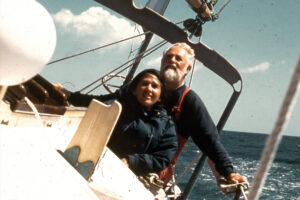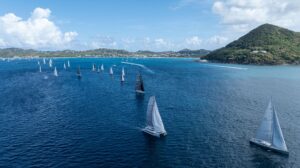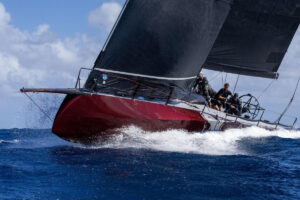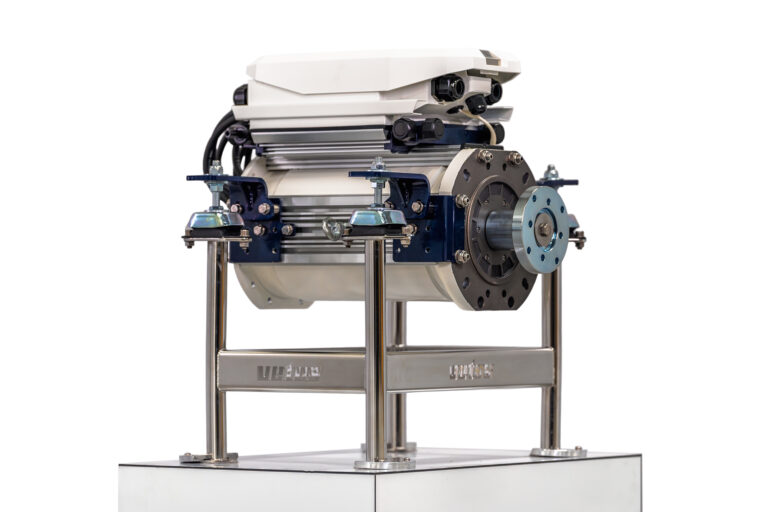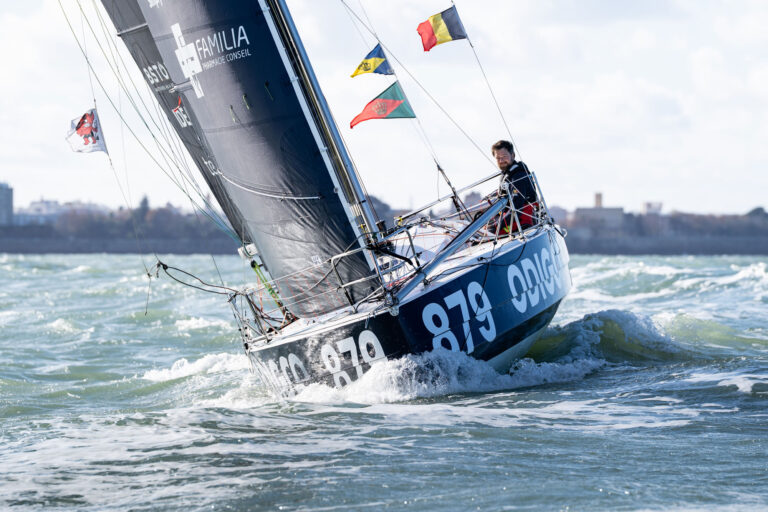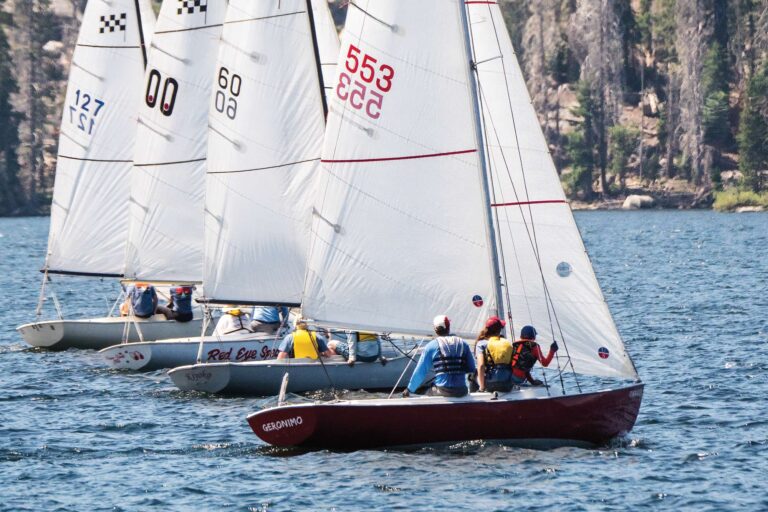
When Beneteau introduced the Sense sailboat series two years ago, I recall climbing aboard the sleek-looking 50-footer at the U.S. Sailboat Show in Annapolis, Maryland, and thinking, “Great boat for a party.” With nearly 16 feet of beam, a wide-open cockpit, and a companionway with only three shallow steps leading into an airy and spacious saloon, the then-flagship of the line just oozed creature comforts. Right away I liked the boat’s looks: plumb stem, slightly reversed transom, wedge-shaped cabin top, the tinted windows looking out into the cockpit, the hard chine carried aft from amidships. I’d have to wait awhile, though, to see how one would actually sail. (See “A Cruising Boat Dons Its Sprinting Shoes,” page 54 of our November 2012 issue.)
And then early this summer, along came the 50’s big sister—same good looks but in a bigger package—and an offer to sail the newly introduced Sense 55 north from Palm Beach, Florida, to Charleston, South Carolina, with Beneteau USA’s president, Wayne Burdick, his wife, Joyce, and their friend Barry Carroll. Right off, my first impression of the Sense line, designed by the French naval architecture firm Berret Racoupeau, with an interior drawn by Nauta Design, was confirmed. It took no time for us to find comfortable spots in which to nest as we pointed the bow toward blue water. Because there are no traditional aft cabins in the accommodations below, the cockpit spans the entire beam aft of the cabin house. At its aft end, a pop-up transom prevents following seas from boarding but allows quick access to the stern swim platform. The twin helms with instrument pods just forward give the skipper plenty of room to work unimpeded by the guests. And they, in turn, can enjoy the ride without toil in the cockpit proper. Wayne joked that around the shop, they describe the design as a “monomaran”—with the space of a catamaran on the footprint of a monohull.
We at first motorsailed into light winds off the starboard bow, the 75-horsepower turbo Yanmar with Dock-and-Go rotating saildrive pushing us along at 7 knots in calm seas. The readout on our Raymarine chart plotter jumped to 9 and better once we hit the Gulf Stream. It would be the next day before the wind freshened enough to kill the engine for any length of time and reach along under main and 105-percent genoa (a self-tacking jib is also available). But when we did, the boat steered like a dream with its twin rudders; the hard chine kept us upright; and from there we just accelerated. Our speed over the ground, in about 11 knots of breeze, hovered consistently in the 9s.

In addition to the signature archway over the companionway, which doubles as an anchor for the mainsheet and a support for a dodger, this model sported a second overhead arch aft, on which were mounted davits, the aft edge of the bimini, as well as solar panels and a pair of wind generators. The shade of the bimini was greatly appreciated.
Toward dinnertime, Joyce retreated to the saloon and starboard-side galley, where she tossed a fine salad and warmed California-style pizza. We dined around the large cockpit table—it easily could’ve handled twice our number—and shortly after dark, tucked a single reef into the main (it’s mounted with lazy jacks and a boom pouch) for the night.
With all the hatches closed, it was warm below, and I found it hard to settle into the motion in the centerline queen island berth far forward in the owners cabin. At anchor, though, this would be a very comfortable retreat, with lots of storage and a private head and shower. Instead, I found the port bench in the cockpit to be a stellar sea berth, and that’s where I got comfortable until it was my turn to take the late-night watch. My mates, meanwhile, found good sleeping below in the midships cabins, each with double queen bunks and their own heads.
Morning coffee was brewed in an electric coffeemaker held on the gimbaled stovetop by secure fiddles and powered by the inverter. Other electrical luxuries included air-conditioning, a dishwasher, washer and dryer, a 9-kilowatt generator, electric blinds and washboards, a microwave, three electric heads, and a fine Pioneer entertainment system.
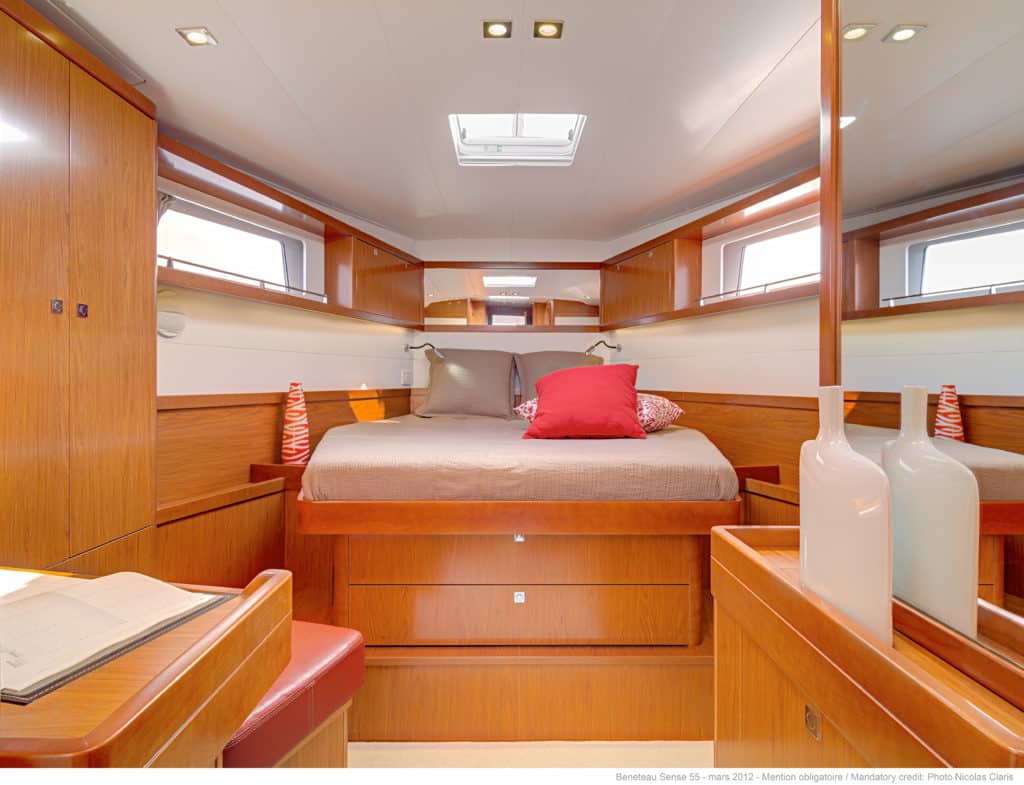
The Sense hulls are hand-laid solid glass and polyester resin, with a layer of vinylester resin sandwiched under the gelcoat to prevent blistering. The deck is a glass-and-balsa laminate (solid glass where hardware is mounted) that’s bonded to the hull. The cast-iron keel (shallow draft on this boat) is bolted and bonded with stainless-steel bolts and counter plate.
Opening overhead hatches provide good airflow below, and the interior of the boat has a bright aura thanks to light-colored upholstery, white wall panels, and joinery in an Alpi product called fruitwood.
As comfortable as the ride up the coast was, it was our second night that proved the most memorable. All evening we watched lightning pummel the coast 20 miles or better to the west. We motorsailed most of the evening, but by the midnight watch change, the wind had died to the point where with three of us on deck, we doused the main to save it from slatting. Joyce already had lowered the electric-powered cockpit table and spread out the cushions to make a comfortable outside double berth. With three hours to my trick at the wheel, that’s where I chose to nap, and I’d just drifted off to sleep when the first raindrops fell. By the time I’d run below and donned my foul-weather gear, gusts hit, and all 55 feet and 40,000 pounds of boat lurched onto its side. Wayne, on the wheel, eventually brought the boat back nearly into the wind, and with the throttle opened wide, managed to maintain headway—barely—and steerage. Steep waves soon engulfed us as 50 knots plus of sustained wind ripped the tops from the waves. Lightning crashed all around us in a grizzly show that lasted well over an hour. Tethered as I was to the sturdy stainless-steel handrail running the length of the cockpit, and somewhat protected by the dodger, my first impressions of the Sense as a party boat quickly vanished. “Great boat for a blow,” I concluded.
Mark Pillsbury is CW‘s editor.
View photos of the Beneteau Sense 55 here.
To read more Cruising World reviews of Beneteau sailboats, click here. To visit Beneteau America’s website, click here.

